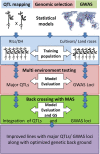Integrating omic approaches for abiotic stress tolerance in soybean
- PMID: 24917870
- PMCID: PMC4042060
- DOI: 10.3389/fpls.2014.00244
Integrating omic approaches for abiotic stress tolerance in soybean
Abstract
Soybean production is greatly influenced by abiotic stresses imposed by environmental factors such as drought, water submergence, salt, and heavy metals. A thorough understanding of plant response to abiotic stress at the molecular level is a prerequisite for its effective management. The molecular mechanism of stress tolerance is complex and requires information at the omic level to understand it effectively. In this regard, enormous progress has been made in the omics field in the areas of genomics, transcriptomics, and proteomics. The emerging field of ionomics is also being employed for investigating abiotic stress tolerance in soybean. Omic approaches generate a huge amount of data, and adequate advancements in computational tools have been achieved for effective analysis. However, the integration of omic-scale information to address complex genetics and physiological questions is still a challenge. In this review, we have described advances in omic tools in the view of conventional and modern approaches being used to dissect abiotic stress tolerance in soybean. Emphasis was given to approaches such as quantitative trait loci (QTL) mapping, genome-wide association studies (GWAS), and genomic selection (GS). Comparative genomics and candidate gene approaches are also discussed considering identification of potential genomic loci, genes, and biochemical pathways involved in stress tolerance mechanism in soybean. This review also provides a comprehensive catalog of available online omic resources for soybean and its effective utilization. We have also addressed the significance of phenomics in the integrated approaches and recognized high-throughput multi-dimensional phenotyping as a major limiting factor for the improvement of abiotic stress tolerance in soybean.
Keywords: abiotic stress tolerance; genomics; ionomics; phenomics; proteomics; soybean; transcriptomics.
Figures
Similar articles
-
Omics Approaches for Engineering Wheat Production under Abiotic Stresses.Int J Mol Sci. 2018 Aug 14;19(8):2390. doi: 10.3390/ijms19082390. Int J Mol Sci. 2018. PMID: 30110906 Free PMC article. Review.
-
Integrated omics approaches for flax improvement under abiotic and biotic stress: Current status and future prospects.Front Plant Sci. 2022 Jul 25;13:931275. doi: 10.3389/fpls.2022.931275. eCollection 2022. Front Plant Sci. 2022. PMID: 35958216 Free PMC article. Review.
-
Advances in Omics Approaches for Abiotic Stress Tolerance in Tomato.Biology (Basel). 2019 Nov 25;8(4):90. doi: 10.3390/biology8040090. Biology (Basel). 2019. PMID: 31775241 Free PMC article. Review.
-
Conventional and Omics Approaches for Understanding the Abiotic Stress Response in Cereal Crops-An Updated Overview.Plants (Basel). 2022 Oct 26;11(21):2852. doi: 10.3390/plants11212852. Plants (Basel). 2022. PMID: 36365305 Free PMC article. Review.
-
Recent developments in multi-omics and breeding strategies for abiotic stress tolerance in maize (Zea mays L.).Front Plant Sci. 2022 Sep 23;13:965878. doi: 10.3389/fpls.2022.965878. eCollection 2022. Front Plant Sci. 2022. PMID: 36212378 Free PMC article. Review.
Cited by
-
Genome Editing in Plants: Exploration of Technological Advancements and Challenges.Cells. 2019 Nov 4;8(11):1386. doi: 10.3390/cells8111386. Cells. 2019. PMID: 31689989 Free PMC article. Review.
-
Mechanism of Mepiquat Chloride Regulating Soybean Response to Drought Stress Revealed by Proteomics.Plants (Basel). 2023 May 19;12(10):2037. doi: 10.3390/plants12102037. Plants (Basel). 2023. PMID: 37653954 Free PMC article.
-
Deep Sequencing of Suppression Subtractive Hybridisation Drought and Recovery Libraries of the Non-model Crop Trifolium repens L.Front Plant Sci. 2017 Feb 23;8:213. doi: 10.3389/fpls.2017.00213. eCollection 2017. Front Plant Sci. 2017. PMID: 28280499 Free PMC article.
-
Analysis of EF-Hand Proteins in Soybean Genome Suggests Their Potential Roles in Environmental and Nutritional Stress Signaling.Front Plant Sci. 2017 May 24;8:877. doi: 10.3389/fpls.2017.00877. eCollection 2017. Front Plant Sci. 2017. PMID: 28596783 Free PMC article.
-
Deep Super-SAGE transcriptomic analysis of cold acclimation in lentil (Lens culinaris Medik.).BMC Plant Biol. 2017 Jun 30;17(1):111. doi: 10.1186/s12870-017-1057-8. BMC Plant Biol. 2017. PMID: 28666411 Free PMC article.
References
-
- Akond M., Schoener L., Kantartzi S., Meksem K., Song Q., Wang D., et al. (2013). A SNP-based genetic linkage map of soybean using the SoySNP6K Illumina Infinium BeadChip genotyping array. J. Plant Genome Sci. 1, 80–89 10.5147/jpgs.2013.0090 - DOI
-
- Bastien M., Sonah H., Belzile F. (2014). Genome wide association mapping of Sclerotinia sclerotiorum resistance in soybean with a genotyping by sequencing approach. Plant Genome 7, 1–13 10.3835/plantgenome2013.10.0030 - DOI
Publication types
LinkOut - more resources
Full Text Sources
Other Literature Sources




